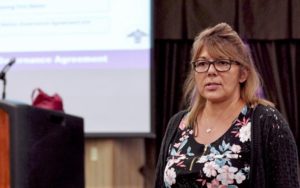Open House in Thunder Bay explores the Anishinabek Nation Governance Agreement

By Rick Garrick
THUNDER BAY— Details of the Anishinabek Nation Governance Agreement were shared by the Anishinabek Nation Restoration of Jurisdiction Department’s Regional Communications Coordinator, Lisa Restoule, at a July 10 open house in Thunder Bay.
“The Anishinabek Nation Governance Agreement has been 25 years in the making,” says Restoule during the information session at the Victoria Inn. “In 1995, a Grand Council resolution was signed by the Chiefs-in-Assembly, so everything we are doing comes from the direction of the Chiefs from that time. The Framework Agreement was signed in Sault Ste. Marie, Ontario, in 1998 on how it would be negotiated, and then the Agreement-in-Principle was signed in Nipissing in 2007. And in 2019, the final draft, which is ready for initialing, is now complete.”
Restoule says Restoration of Jurisdiction staff will be meeting with the member Anishinabek Nation First Nations to inform as many people as possible about the Anishinabek Nation Governance Agreement.
“We’re meeting with the First Nations to get BCRs (Band Council Resolutions) to give permission for the negotiating team to initial off on the Agreement and to hold a vote in your community,” Restoule says.
Restoule adds that the Anishinabek Nation Governance Agreement is between the Anishinabek Nation First Nations, the Anishinabek Nation and the federal government.
“This Agreement covers four law-making areas only — we’re looking at language and culture; citizenship; leadership selection, Chief and Council elections; and management and operations,” Restoule says. “There is a governance portion that First Nations operate under, everything else will remain under the Indian Act. The direction came from the Chiefs-in-Assembly to do just governance, the same as it was with education— just to stay focused on that. So we are not getting completely out of the Indian Act.”
Information about the Anishinabek Nation Governance Agreement is available online.
“It provides formal recognition by Canada to recognize our inherent right,” Restoule says. “Basically, what this Agreement did when we negotiated it is we educated Canada on what our inherent rights are and the ones we never gave up. We always governed and we said, ‘This is what we are going to do — we are going to govern and we will decide how we govern. We are going to make all the laws.’”
Restoule says any laws created by a First Nation in the four areas stipulated in the Anishinabek Nation Governance Agreement will no longer be sent to the federal government for approval.
“They won’t be codes, they won’t be bylaws, they will be your own First Nation law,” Restoule says. “They get sent to your community and the First Nation government answers to the citizens, not to the Minister of (Indigenous and Northern Affairs Canada). So if there is an appeal of a First Nation election law, there has got to be a mechanism set up within your community to have that appeal heard by the people, not (INAC).”
Restoule says the Anishinabek Nation Governance Agreement features a five-year fiscal arrangement that will be re-negotiated every five years.
Restoule says each First Nation will receive a minimum of $1.7 million annually for governance activities. It is expected that the First Nations who passed BCRs will vote on the Anishinabek Nation Governance Agreement later this fall.

